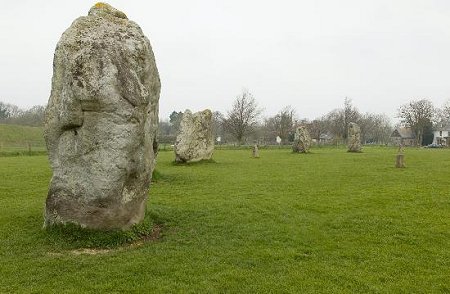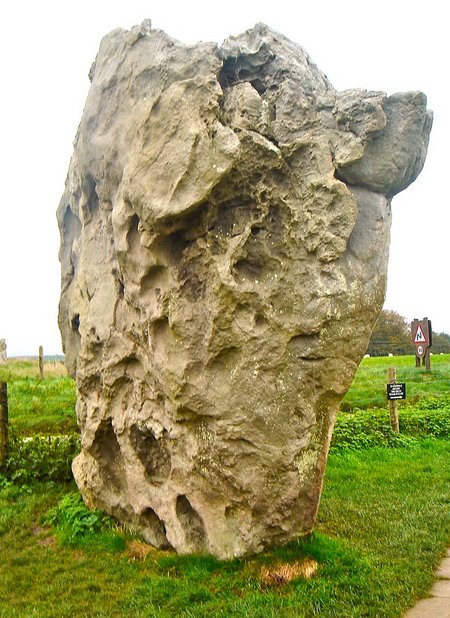Avebury
The world-famous stone circle on the edge of Swindon
Nobody who has ever entered the stone circle at Avebury can fail to have felt - even for just a second - that there could be some strange, ancient power operating within its circumference.
Even the local church, which has been there since Saxon times, seems to have been deliberately placed outside the circle so as not to interfere with the forces within.
But while generations of men have speculated about the significance of this strangest of villages, as much fantasy as fact has been offered in an attempt to explain its purpose. This article does not attempt to put forward a theory about what Avebury is because centuries of scholars have failed to agree on its purpose. It is perhaps more important to establish what Avebury is not. Astrologers and would-be druids may be disappointed by what they are about to read.
Entering Avebury's stone circle from the north can be quite an experience. The road sweeps around and without warning confronts every driver and passenger with one of the largest stones in the village. It stands like a sentry, almost hanging over the road, and weighs in at over 60 tonnes.
If the weather is misty or stormy, it is an even more impressive sight.
This stone is one of the few to have a name - the 'Diamond Stone' (because of its shape) or, more commonly, the 'Swindon Stone' (because it is on the Swindon road).
The Swindon Stone (pictured, below) is also one of the few to have remained standing since it was first placed there, at least 4,000 years ago. The road appears to have been here since ancient times and the Swindon Stone certainly seems to have been chosen to be an imposing gateway to the complex of stones, along with its twin, which stood across the road.
No wonder mystic powers have been attributed to it over the years, though stories that it revolves on its own axis at midnight may only be collaborated by well-oiled customers from the nearby Red Lion. The same surely applies to other legends and fantasies that have been attributed to the stones over the years. For instance, local legend has it that if anyone runs 100 times anti-clockwise round 'The Devil's Chair', the large, rectanglar stone at the southern end of the circle, then this will summon up supernatural powers and possibly even the devil. These are charming stories and pleasant anecdotes to a place that, after all, does lends itself to fairytales, but not for a moment should we believe that they have any factual value, nor any of the many other fanciful theories about the stones' origins. However impressive the stones are to us today, their significance has to be put in context with the other historical sites in the vicinity. Though the village is at the heart of an area overflowing with important remnants from an ancient time, the stones are by no means the most important part of the jigsaw.
The first settlements at Avebury were at Windmill Hill, about one mile to the north-west of the present village, and also at The Sanctuary, across and beyond the village to the south-east. Both these sites were in use between 5,000 and 6,000 years ago. Windmill Hill was a causewayed 'camp' while The Sanctuary was the site of a large wooden building, probably used for ceremonial purposes. Little remains of either of these structures, but much remains of the next important project by the local people - West Kennet Long Barrow. That was built some time within 200 years of Windmill Hill and is one of the best examples of an ancient chambered tomb to be found anywhere in the world. It was another millenium before Silbury Hill (pictured, above) was begun in around 2,700BC. The purpose of this, the largest man-made mound in Europe, remains a mystery as no evidence of its use for religious purposes has been discovered and it appears that nothing of any significance is at its core. As it stands in a valley it would have been useless as a strategic position. Even today and despite the fact that it stands 39.5m (130ft) high, it can be difficult to spot when approached from certain directions. So, in 2600BC, the Avebury area was important because it had Windmill Hill, The Sanctuary, West Kennet Long Barrow and Silbury Hill among other sites. Some time in the next 500 years the local people also decided to construct the famous stone circles and a large bank and ditch. The reasons for this were certainly not military. The bank is outside the ditch and would have been better at keeping people in than keeping intruders or invaders out. There are also many reasons why Avebury cannot be some kind of giant astronomical observatory or calendar, for instance, as many have supposed. Druids - ie sun worshippers - certainly did not build Avebury because this was a cult that grew up from around 300BC when the Avebury stones had already been standing for about 2,000 years and possibly longer. Neither has the circle been proved to align with any astronomical features or events - except one. Avebury is made up of one large circle of stones inside which are two smaller inner circles and one of these (the 'Northern Inner Circle') has a central feature ('The Cove') which used to be made up of three stones. This may have been roughly aligned on the moon's most northerly rising point. But it is only a rough alignment and astronomers - even ancient ones - are not usually in the habit of putting themselves to a lot of trouble merely to record approximate positions. The two inner circles are also off-centre from the main circle, suggesting they are of lesser importance than the main circle itself. What really casts doubt over these flights of astronomical and astrological fancy is staring us in the face. The stones are clearly unworked.
Stonehenge
Unlike at neighbouring Stonehenge, the stones have not been measured and shaped, but rather hauled out of the ground so that they can be re-buried at Avebury in their original state.
With the benefit of air travel we can also see that the stones have not been placed in a perfect circle. Neither has the bank and ditch, which was an even greater feat of management and engineering than the placing of the stones. Everything, then, would point to the circle being symbolic rather than functional. This is perhaps best demonstrated by the West Kennet Avenue, which only partly survives today. This is a processional walkway, marked by alternating diamond- and slab-shaped stones, possibly symbolising male and female, and linking the village with the site of The Sanctuary. Neither this avenue nor its long-gone contemporary, the Beckhampton Avenue, are straight, which underlines the fact that symbolism, not their positions, are significant. We cannot say whether the avenues were built to link Avebury to the more ancient sites or vice versa, but the great stone circles seem almost an afterthought, dreamed up and executed by later generations as an addition to their cult or culture. The best thing about Avebury is that, after thousands of years of scratching heads over its function and with no answers to the question, everybody's idea of why it all exists is as good as the next man's. In the absence of evidence, even the claims of pagans and astrologers must be considered. But let us not lose sight of what makes Avebury so special. It is a village that is above all that mumbo jumbo. Though it is an historic site in a massively important area, it is as much an inspiration to the casual visitor as it is the academic historian. Avebury Factfile The outer circle was originally made up of 98 stones which enclosed two smaller, inner circles. The Northern Circle was formed by 27 outer stones around a central feature, The Cove, which was made up of three stones. The nearby inner Southern Circle had 29 stones and 12 inner stones which formed the 'Z-feature'. The West Kennet Avenue had around 100 pairs of stones and the Beckhampton Avenue possibly even more. The worst destruction of Avebury was carried out towards the end of the 17th Century and into the early 18th Century. Local builders broke up many stones by lighting fires underneath the stones, then pouring cold water on them to cause cracks. It is only in the last 60 years that Avebury has been partly restored to its former glory. Until Alexander Keiller bought the site in the 1930s and began to reconstruct it, only four stones were still standing and fully in view. In 1668 Avebury and the surrounding area was visited by Samuel Pepys who wrote about it in his famous diary. The Barber-surgeon Stone, which stands close to the southern end of the outer circle, is named after the unfortunate man who was crushed beneath it in the early 14th Century while it was being buried. At his waist he had a small pouch containing scissors, an iron probe and coins dated c1310. Discovered in 1938, his skeleton was destroyed during the Second World War after receiving a direct hit from a German bomb during studies in London. The stone closest to the High Street in the south-west sector was found buried in the foundations of a blacksmith's forge. It was re-assembled by Alexander Keiller during his restoration in the 1930s but still shows signs of damage. The winding course of the West Kennet Avenue has puzzled generations of archaeologists. Most believe that it vered around buildings of unknown origin. The ditch, which is on average 6.5m (22ft) outside the outer circle was dug with antler picks and rakes, ox-shoulder blades, wooden shovels and baskets. It was sunk to a depth of up to 9m (30ft) and would have been topped with chalk. It is estimated that the digging of the ditch and the erection of the stones took around 1.5 million man hours of work. The Swindon Stone, which is one of the few that has never fallen, weighs 64.5 tonnes. Most of the others weigh at least 20 tonnes. The A4, which passes close to Silbury Hill, was originally a Roman road. They lined up the road on the hill but it veered around it. West Kennet Long Barrow is 100m (328ft) long, but the stone burial chambers (a cluster of five) extend only 12m (40ft) into the mound. Archaeologists have discovered remains from 46 different people, but in many cases skeletons were incomplete. Historians believe rituals did not involve the burial of whole corpses. Nearly all adults had arthritis and some showed signs of spina bifida, a comparatively rare disease. Bodies were buried in chambers according to age and sex. Local builder Tom Robinson is responsible for most of the destruction of The Sanctuary who cleared the ground in 1724 "to gain a little dirty profit", according to historian William Stukeley. Avebury is a World Heritage Site - the closest one to Swindon. |
|
||||||||
|
||||||||










